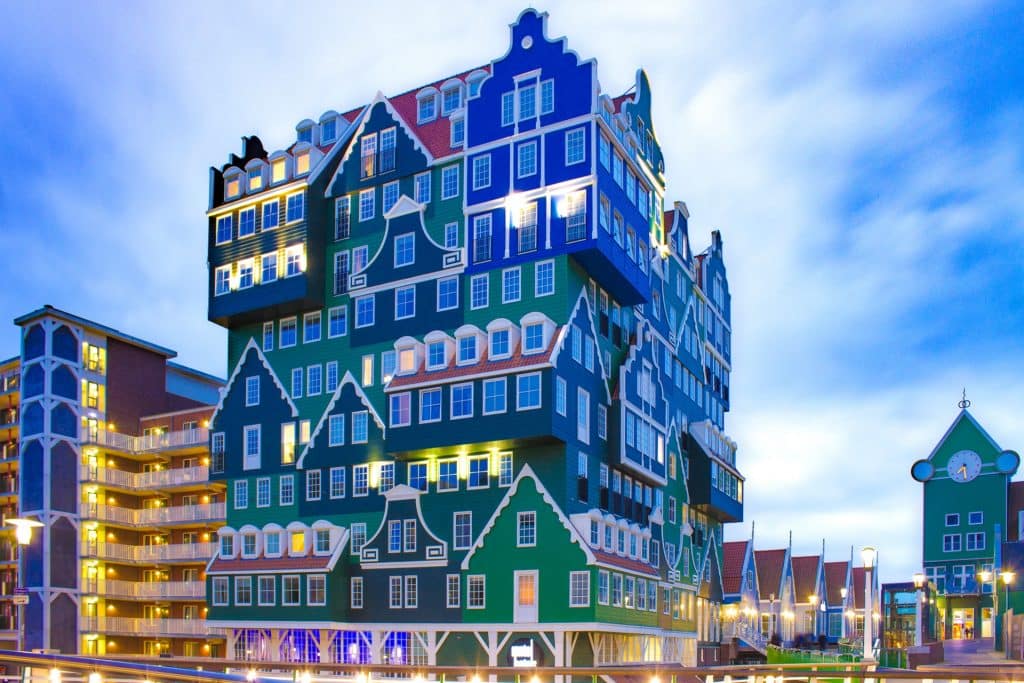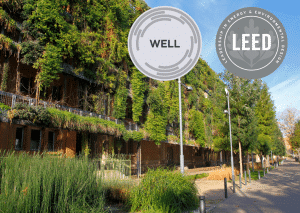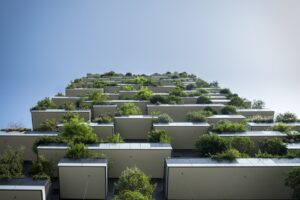Chances are you might have come across the term “Zero Energy Building” quite a few times in recent years. The reason behind this is that as the world is grappling to cope with climate change and global warming, every industry is looking to minimize its emissions and shift to renewable energy. This is particularly true of the building sector that has often been blamed for having a massive impact on the environment.
This is because during their construction, occupancy, renovation and even demolition, buildings use huge amounts of energy, natural resources and raw materials. They generate large quantities of waste and emit planet-harming carbon emissions.
However, the building sector can significantly reduce energy use by incorporating energy-efficient strategies into the design, construction, and operation of new buildings and undertaking retrofits to improve the efficiency of existing buildings. It can further reduce dependence on fossil fuel derived energy by increasing use of on-site and off-site renewable energy sources.
This determination to minimize the environmental impact of buildings gave rise to the concept of Zero Energy Buildings (ZEBs). A zero energy building is also referred to as net zero building.
ZEBs have emerged in response to stringent environmental standards, both regulatory and voluntary, introduced to address increasingly significant environmental issues such as climate change, natural resource conservation, pollution, ecology, and population.
The development of modern zero-energy buildings became possible largely through the progress made in new energy and construction technologies and techniques. These include highly insulating spray-foam insulation, high-efficiency solar panels, high-efficiency heat pumps and highly insulating, low emissivity, triple-glazed windows.
Also, ZEBs need to produce their own energy on site to meet their electricity and heating or cooling needs. Various microgeneration technologies may be used to provide heat and electricity to the building, including the following:
- Solar (solar hot water, photovoltaics)
- Wind (wind turbines)
- Biomass (heaters and stoves, boilers, and community heating schemes)
- Combined heat and power (CHP) and micro-CHP for use with natural gas, biomass, sewerage gas, and other biogases
- Community heating (including utilizing waste heat from large-scale power generation)
- Heat Pumps (air source and ground source and geothermal heating systems)
- Water (small-scale hydropower)
- Other (including fuel cells using hydrogen generated from any of the above renewable sources)
What is a zero energy building?
Generally speaking, a zero energy building produces enough renewable energy to meet its own annual energy consumption requirements, thereby reducing the use of non-renewable energy in the building sector. This definition also applies to campuses, portfolios, and communities.
As the “zero energy” and “net zero energy” concepts are relatively new, there are not yet definitive, widely accepted zero-energy metrics. The Department of Energy (DOE) and the National Renewable Energy Laboratory (NREL) have spearheaded much of the work on net zero energy buildings to date. NREL presents several definitions for “net zero energy”, and they encourage building designers, owners, and operators to select the metric that best fits their project.
A publication from NREL suggests four ways in which net zero energy may be defined:
- Net Zero Site Energy
- Net Zero Source Energy
- Net Zero Energy Costs
- Net Zero Energy Emissions
Site Energy refers to the energy consumed and generated at a site, regardless of where or how that energy originated. In a net zero site energy building, for every unit of energy the building consumes over a year, it must generate a unit of energy.
Source Energy refers to primary energy needed to extract and deliver energy to a site, including the energy that may be lost or wasted in the process of generation, transmission and distribution. For example, a coal-burning power plant may generate 1 Joule of electricity for every 3 Joules of energy in the coal consumed. If natural gas is used at a site, for every 20 Joules consumed, 1 Joule may be needed to extract and distribute the gas to the site. Metrics for net zero source energy buildings account for these factors, though exact metrics can vary depending on site and utility factors.
Net Zero Energy Cost is perhaps the simplest metric to use – it means that the building has an energy utility bill amounting to zero over the course of a year. In some cases, building owners or operators may take advantage of selling Renewable Energy Credits (RECs) from on-site renewable generation.
Many conventional energy sources result in emissions of carbon dioxide, nitrogen oxides, sulfur dioxide etc. A Net Zero Energy Emissions building either uses no energy which results in zero emissions or offsets the emissions by exporting emissions-free energy (typically from on-site renewable energy systems).
Since the ZEBs produce almost all the energy they require, some of them might be independent from the national electricity grid. However, most ZEBs are connected to the grid, allowing for the electricity produced from traditional energy sources (natural gas, electric, etc.) to be used when renewable energy generation cannot meet the building’s energy load.
When, conversely, on-site energy generation exceeds the building energy requirements, the surplus energy should be exported back to the utility grid, where allowed by law. The excess energy production offsets later periods of excess demand, resulting in a net energy consumption of zero.
Due to current technology and cost limitations associated with energy storage, grid connection is usually necessary to enable the Net Zero Energy balance.
What are the prospects of zero energy buildings?
The World Green Building Council (WGBC), and the Green Building Councils participating in the Advancing Net Zero project, are dedicated to supporting market transformation towards 100% net zero carbon buildings by 2050.
WorldGBC recognizes that in most situations, net zero energy buildings, i.e. buildings that generate 100% of their energy needs on-site, are not feasible. Therefore, buildings that are energy efficient, and supply energy needs from renewable sources (on-site and/or off-site) is a more appropriate target for the mass scale required to achieve Paris Agreement levels of global emission reductions.
WorldGBC believes that this enormous challenge will be achieved through the coordinated efforts of businesses, governments, and NGOs; and their Green Building Councils in various countries are leading the way.
In the United States, a number of efforts are underway to achieve zero net energy (ZNE) in the built environment. Zero net energy buildings and communities, as currently conceived, are one method to advance energy efficiency and renewable energy technology and to reduce total greenhouse gas emissions from the built environment. The definition of ZNE buildings continues to evolve and may ultimately shift as society pursues a low-carbon future.
Why are net zero energy buildings important?
ZEBs offer numerous benefits and advantages for the world and those who live and work inside the buildings. While the design and construction may be more costly than standard structures, the long-term return on investment makes the energy-efficient buildings a better option. Here are four of the main benefits of ZEBs:
- Increased Value: ZEBs can improve or maintain your competitive advantage against other buildings, improve the value of your property, mitigate market risk, while also promoting the health and well-being of the building occupants.
- Saves Money: The buildings are 60-90 percent over energy efficiency baselines. This means that a project will save money in the long-run over the entire lifecycle of its equipment, as well as in energy and maintenance costs.
- Educational: ZEBs serve as a great way to show the benefits of energy-efficiency to the world. Everyone who is involved during the design, construction, and operations, as well as the occupants working/living inside the facility, gain valuable knowledge and understanding about energy-efficiencies and the technology used. Also, occupants can make connections and will learn how to limit their own energy use in their personal lives.
- Reduces greenhouse gases: By limiting building’s dependence on fossil fuels, or even eliminating any need for them, ZEBs are creating a more resilient future that benefits us, younger generations, and the world.
How much does it cost to build a net zero building?
While there are more building owners interested in learning more about net zero, for many, cost is still a primary concern. According to Vuk Vujovic, LEED AP BD+C, vice president, director of sustainability and energy at Legat Architects, Chicago, some clients still perceive the effort to get to net zero building operation too great or the overall cost too high.
“This prevents them from actively pursuing available opportunities or considering net zero implementation in the first place,” he notes.
In general, net zero usually requires more upfront funding than typical buildings. “However,” Vujovic adds, “this perspective should be modified to include annual paybacks, available grant funding, and added resiliency and disaster preparedness capabilities that are inherent to net zero operation.”
The Getting to Zero report notes the costs for getting to zero are not distinguishable from overall project costs. While energy efficiency and renewable technologies have specific costs, the design and technology tradeoffs due to the advanced systems blur the line of incremental costs.
Additionally, green, LEED and/or zero net energy building costs are within the range of other like-type buildings. When the total construction costs for these building are analyzed versus a control group, the projects’ costs are comparable.
While the primary concern around building to net zero is up-front cost, Mark Roddy, FAIA, LEED AP BD+C, vice president, design principal at SmithGroupJJR, San Francisco, says it’s the operational costs that really make a difference. “If you can have a conversation about how much money they’re going to be spending over the life of the building or for the next 10, 15 years, etc., that’s where the real value proposition comes in,” he says.
ZEBs – Some examples:
Listed below are two commercial examples of ZEBs that can inspire others to follow suit:
In June 2010, the National Renewable Energy Laboratory (NREL) completed the construction of Phase 1 of their Research and Support Facility (RSF). Located in Golden, Colorado, the RSF is currently the largest ZEB in the U.S. The 220,000 sq. ft. project achieved the Net Zero site energy goal through a performance-based design/build process. Numerous energy efficiency strategies were implemented including incorporating advanced heat recovery technologies that were developed and designed by researchers at the Lab and installing 1.6 megawatts of photovoltaic power on the campus through a Power Purchase Agreement. Additionally, daylighting, natural ventilation, and a next-generation, energy efficient data center are among the other energy features of the building.
The Adam Joseph Lewis Center for Environmental Studies, located on the Oberlin College campus in Oberlin, Ohio, is another example of a Net Zero Energy site energy building. The Lewis Center is an all-electric building and was designed with maximum energy efficiency in mind. The Center generates its own on-site electricity through a roof mounted 60 kW PV system and a 100 kW PV system located over the parking lot. The Center is “grid-interconnected”, meaning that when the solar panels produce more electricity than the Center consumes, electricity is exported to the City of Oberlin. Since the parking lot PV array was added in May of 2006, the Center has been a net exporter of electricity – producing more electricity on an annual basis than it consumes. Solar electricity production is coupled with energy efficient lighting, heating, and appliances to minimize negative environmental impact.
With inputs from:
- https://www.wbdg.org/resources/net-zero-energy-buildings
- https://www.schneider-critical.com/blog/four-benefits-net-zero-energy-buildings/
- https://www.metalarchitecture.com/articles/cost-of-net-zero










